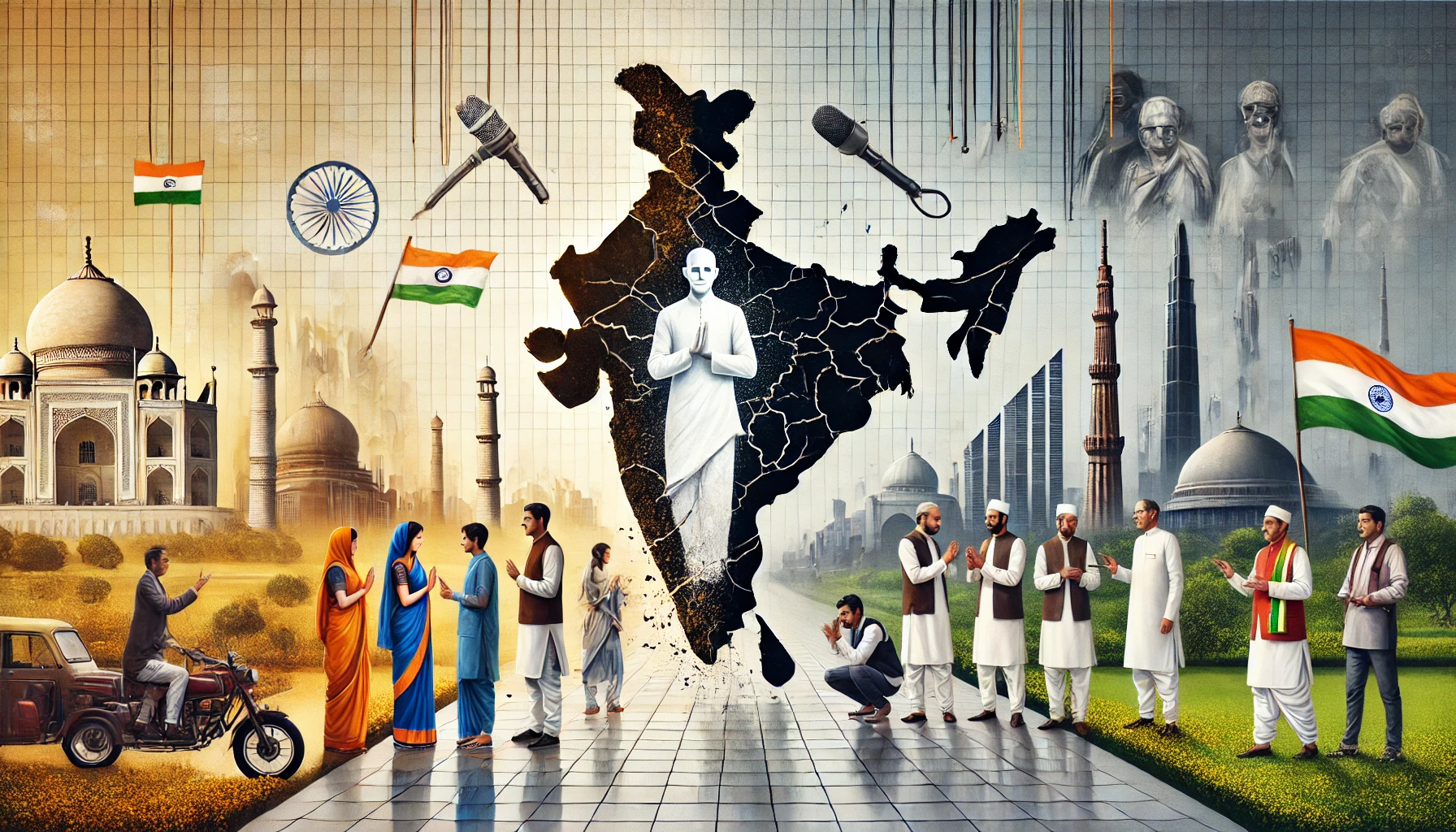India, the world’s largest democracy, has long stood as a testament to pluralism. Yet today, that pluralistic foundation is being systematically undermined. A toxic mix of historical revisionism, political opportunism, and media complicity is fueling an increasingly volatile Hindu-Muslim divide. What’s unfolding isn’t the product of ancient hatred—it’s a modern political strategy.
Divide and Rule: The Colonial Blueprint That Never Ended
For centuries, Hindus and Muslims shared a complex yet often peaceful history—living, trading, and thriving together across the subcontinent. The British colonial administration, seeking to suppress unified resistance, weaponised religion through policies that fractured communities. They introduced separate electorates in 1909 and reinforced sectarian categories in censuses and public appointments.
The 1874 Bombay riots are particularly revealing. They were not Hindu-Muslim clashes, but a united uprising of Hindus and Muslims against Parsis and Anglo-Indians amid economic hardship. Such examples are stark reminders that the rigid binaries of today were not always part of the Indian experience.
From Margins to Mainstream: RSS, Shiv Sena and the Normalisation of Hate
Post-independence, India’s constitutional promise of secularism faced ideological pushback. The RSS (Rashtriya Swayamsevak Sangh), founded in 1925, envisioned a Hindu nation. Inspired by European fascist movements, it emphasised militarism, cultural purity, and the subjugation of minorities. Its ideological offspring, the Bharatiya Janata Party (BJP), would carry this vision into governance.
Shiv Sena, formed in 1966, initially targeted South Indian migrants in Mumbai before shifting its ire towards Muslims. The 1992–93 Bombay riots—following the demolition of the Babri Masjid—saw Shiv Sena leaders openly incite violence. Justice B.N. Srikrishna’s commission found the group complicit, yet accountability was elusive.
The BJP’s Ascent: Power, Propaganda and Polarisation
Narendra Modi’s rise to power in 2014 was a watershed moment. Backed by the organisational strength of the RSS and a compliant media ecosystem dubbed the “Godi media,” the BJP mainstreamed Hindutva politics. Channels like Republic TV, Times Now, and Zee News amplified fringe narratives—”Love Jihad,” “land jihad,” and Muslim overpopulation—into national anxieties.
As Delhi-based academic Apoorvanand notes, “We are witnessing the institutionalisation of bigotry. What was once said in whispers is now state policy.”
Weaponising Non-Issues: From Triple Talaq to Article 370
The BJP has mastered the art of inflating non-issues for political gain. The ban on triple talaq, for instance, affected a minute fraction of Muslim women. Yet it was turned into a spectacle of women’s empowerment—without equivalent reforms in Hindu personal law.
Similarly, Muslim birthrates were portrayed as an existential threat, despite National Family Health Survey data showing fertility rates are declining across all communities.
The abrogation of Article 370 in Kashmir was heralded as a triumph of national integration. On the ground, it led to disenfranchisement, arrests, and economic distress in India’s only Muslim-majority region.
Temples, Mosques and a Manufactured Crisis of Identity
The narrative that India’s mosques were built over Hindu temples has been exploited to justify aggressive reclamation efforts. The Babri Masjid demolition in 1992 was a turning point. Now, cases surrounding the Gyanvapi Mosque in Varanasi and the Shahi Idgah in Mathura follow the same playbook.
“Faith cannot be built on falsehood and revenge,” says Zafar Sareswala, a prominent Muslim businessman close to Modi. “If we keep digging into the past, we will bury our future.”
The Numbers Don’t Lie: Sachar and Kundu Reports on Muslim Disadvantage
In 2006, the Sachar Committee painted a sobering picture: Muslims were among the most socioeconomically marginalised communities in India. Disparities were evident in education, employment, and housing. Muslims were underrepresented in public institutions and overrepresented in informal and precarious jobs.
The 2014 Kundu Committee found little had changed. Instead of targeted interventions, successive policies have erased minority-focused welfare in favour of “development for all” slogans that often leave the most vulnerable behind.
Culture Wars and Control: Aurangzeb and the Wakf Amendment Bill
The vilification of Mughal emperor Aurangzeb is symbolic of the broader rewriting of India’s history. Historians agree that Aurangzeb’s rule, while autocratic, was no more so than other monarchs of his era. Yet in today’s discourse, he is presented as the archetypal Muslim tyrant.
Meanwhile, the 2023 Wakf Amendment Bill has quietly expanded state control over Muslim charitable trusts. These properties—schools, hospitals, mosques—serve millions. Critics say the bill opens the door to expropriation under the guise of transparency.
Hyderabad MP Asaduddin Owaisi called it plainly in Parliament: “This is not regulation. It’s a land grab.”
Reimagining India: From Fear to Fellowship
Zafar Sareswala offers a hopeful path forward: “The Indian Muslim wants progress, education, and peace—not confrontation. What we need is leadership that unites, not divides.”
To that end, five interventions are critical:
- Revise the curriculum to include shared cultural histories, pluralistic narratives, and critical thinking.
- Strengthen independent journalism by supporting nonpartisan outlets and holding hate-promoting networks accountable.
- Launch national interfaith dialogues in schools, media, and public forums to normalise diversity.
- Push political parties to centre economic justice—jobs, education, healthcare—over identity politics.
- Create platforms for reconciliation, especially in conflict-prone regions like Uttar Pradesh and Kashmir.
India’s Test: Unity in an Age of Division
India’s Muslim population exceeds 250 million. Its geographic neighbours—Pakistan, Bangladesh, Indonesia—are Muslim-majority nations. To marginalise Muslims domestically is not only immoral but geopolitically unwise.
The late Mahatma Gandhi famously said, “Our ability to reach unity in diversity will be the beauty and the test of our civilisation.”
That test is now. And how India answers will shape not only its future—but the world’s largest democracy’s very soul.




